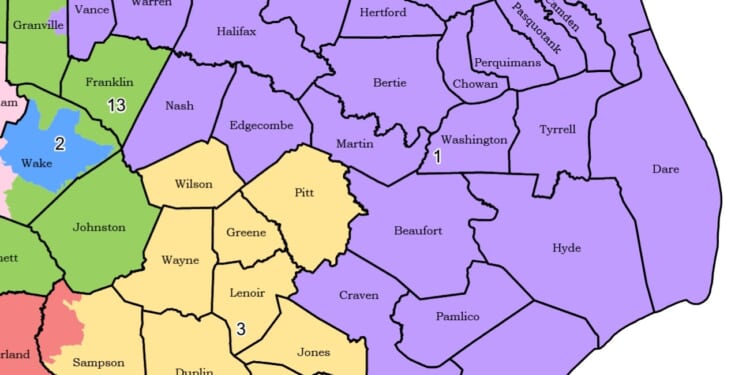- The North Carolina General Assembly has joined other states in mid-decade redistricting ahead of the 2026 elections
- Recent redistricting reform legislation has all the elements needed to prevent gerrymandering in North Carolina
- North Carolina should enact redistricting reform well before the next round of redistricting in 2031
The North Carolina General Assembly approved a new congressional map on October 21 to bolster Republicans in the 2026 election. This unnecessary, mid-decade redistricting, while not illegal, is a flagrant gerrymander and yet another reason the state should implement redistricting reform before the 2031 reapportionment.
North Carolina jumps into the national redistricting fight
Most states, by law or tradition, draw new districts only after the decennial nationwide census and do not redraw them for a decade, absent a court order to do so.
Things have changed.
States across the country have taken up mid-decade redistricting. Texas and California took the lead, with plans to gain five more Republican districts and five more Democratic districts, respectively. Other states are joining the fray, including Virginia, Missouri, Maryland, and Florida. Republicans are likely to come out ahead in those exchanges, at least in the short term.
Now, the Republican-controlled North Carolina General Assembly has joined them. With the new map, Republicans are advantaged in 11 of the state’s 14 districts. The new map shifts counties between Democrat Rep. Don Davis’ First District, which had been highly competitive, and Rep. Greg Murphy’s safely Republican Third District. The result is that both districts will elect Republicans in all but the most extreme circumstances.
While the North Carolina State Constitution prohibits the legislature from redrawing state legislative districts mid-decade without a court order, there is no such prohibition for congressional districts.
There will inevitably be lawsuits claiming racial gerrymandering over making the First District, which has elected black Democrats for decades, now lean Republican. Those claims are unlikely to succeed, however. A similar lawsuit over state Senate districts in the same part of the state failed to prove that northeastern North Carolina has significant enough racially polarized voting to justify carving out districts on the basis of race to benefit black voters:
The evidence shows North Carolina (including northeast North Carolina) as a place “where racial animosity is absent although the interest of racial groups diverge” and that politics — not race — explain the voting patterns.
Recent attempts at reform should be revived
When legislators come back for the 2026 short session, they should consider redistricting reform. They wouldn’t even have to create new reform bills (although they could, based on the John Locke Foundation’s 2023 report “Limiting Gerrymandering in North Carolina“). They could just revive and revise the best reform bills that have already been proposed.
Legislators introduced a half-dozen redistricting reform bills in 2019, before the 2020 census and subsequent reapportionment. Two of those bills, House Bill (HB) 69 and HB 140, enjoyed broad bipartisan support with dozens of cosponsors, although neither made it out of committee. They stood above other redistricting reform bills, but for different reasons. All the bills involved redistricting commissions in some form.
Here are some elements from those bills that could be combined into a single redistricting reform bill in 2026:
- Maintain democratic accountability by keeping a legislative role in the process through “a strong role in picking commission members and a more limited role in approving the maps drawn by the commission” (HB 69)
- Be fully bipartisan in how commission members are chosen and how the commission makes decisions (HB 69)
- Incorporate into the North Carolina Constitution the county grouping system created in Stephenson v. Bartlett to limit gerrymandering (HB 140)
- Amend the constitution to require that districts “shall be as reasonably compact as practicable” (HB 140)
- Amend the constitution to ban the use of voter registration, past election results, the location of incumbents’ residences, and any other data “which could identify with reasonable certainty the voting tendencies of any group of citizens” when drawing districts (HB 140)
Those elements could provide the core of a strong bipartisan redistricting reform bill.
Now is the time for reform
Back when Democrats still controlled the General Assembly, John Hood (currently a John Locke Foundation board member) urged them to consider redistricting reform:
Democrats refused. When I urged them to think of redistricting reform as an insurance policy against a catastrophic loss — in this case, having to run in districts drawn by some future Republican legislature — they laughed in my face. Democrats dismissed the prospect entirely. Then they lost, and kept losing, to their great regret.
A red wave election in 2010 overcame Democratic gerrymanders just in time for redistricting in 2011.
Today, it is Republicans who believe it is inconceivable that they could lose control of the state legislature. But nobody knows what the circumstances of the 2030 midterm election will be. While gerrymandering makes it difficult for the party out of power to take over, our state’s recent history proves that it is not impossible.
Another worry for Republicans is that Democrats could regain control of the North Carolina Supreme Court. The last time Democrats controlled the court, they imposed a gerrymandered congressional map that served as a protection plan for Democrats against an expected red wave election. A new Democratic majority could come up with even more extreme “solutions” to gerrymandering. Redistricting reform, especially in the form of constitutional amendments, would alleviate that problem.
Forewarned by the knowledge that a sudden electoral setback could hand control of the state legislature to Democrats for a decade but reassured by the fact that North Carolina is a Republican-leaning state that would give them legislative majorities in most elections without gerrymandering, Republicans in the General Assembly should take advantage of the opportunity to pass redistricting reform in 2026.










